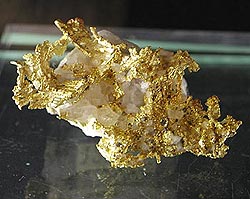Calculating Weight of gold in a Specimen!

The Specific
Gravity Test (used to calculate the gold content of gold nuggets that contain a
mixture of gold and other materials) In this example of the specific gravity test, we use gold mixed with quartz. Simply
put, the formula is 3.1 x the weight in water, minus 1.9 x the weight in
air:
Wet nugget weighs
74.5 grams x 3.1 = 230.95 The specific
gravity for gold is 19.3.
Dry nugget weighs 96 grams x 1.9 =
182.4
230.95 - 182.4 = 48.55
31.1 = number of grams per ounce
48.55
/ 31.1 = 1.56 ounces of gold
Original dry weight = 96 grams / 31.1 = 3.08
ounces.
Subtract the difference between the wet and the dry:
3.08
ounces - 1.56 ounces = 1.52 ounces.
Therefore what is left is 1.52 ounces of
quartz.
"Wet" = weight in water - Put container of water (enough water to
cover nugget) on scale. Tare (zero) out scale. Hang nugget by string in water.
Note weight.
The specific gravity for quartz is 2.65.
The
ratio between gold and quartz is 7.28 X.
| Metal | Symbol | Specific Gravity |
| Copper | Cu | 8.96 |
| Gold | Au | 19.32 |
| Iron | Fe | 7.87 |
| Lead | Pb | 11.34 |
| Nickel | Ni | 8.90 |
| Palladium | Pd | 12.00 |
| Platinum | Pt | 21.45 |
| Silver | Ag | 10.49 |

Example 2
The measurement we really need to
find is volume and this can easily be done if you have a digital scale. Take a
glass or cup that is big enough to hold the rock and fill it with water so that
the rock will easily be covered with water when placed in the vessel. Tie a thin
piece of string around the rock such that it can be suspended in the water in
the vessel so that it is not touching the bottom nor sides and is fully
submerged. Now place the vessel with water without the suspended rock inside and
weigh. Now add the suspended rock and determine the increase in the weight on
the scale. This can either be done by zeroing out (tareing) the scale after the
first measurement or by subtracting the first weight from the second. This
number represents the volume of the rock in cubic centimeters since while the
rock is suspended it is displacing an equal volume of water and mimicking its
density which is 1 gram per cubic centimeter. Therefore the increase in the
weight in grams on the scale equals the volume of the rock in cubic centimeters.
when you get this number it is easy to plug into a formula for determining a
fairly accurate estimate of the gold content. A piece of quartz of equal size
(33.3 cubic centimeters) should way 88.25 grams since quartz has a density of
2.65. The formula for determining gold content in a quartz matrix is: 3.1 x
weight of rock in water minus 1.9 x weight of rock in air The peice we use as an example here is 95.1 grams quartz &
gold specimen If there are minerals in the
rock heavier than quartz like iron oxide then the estimate will run high. From
past experience I tend to think this formula runs a bit high anyway and that the
first number should be between 3 and 3.05. Using this formula in your instance
comes up with: 3.1 x (95.1 - 33.3) - 1.9 x 95.1 = 10.89 grams of gold .
